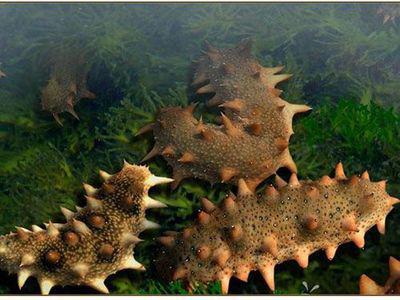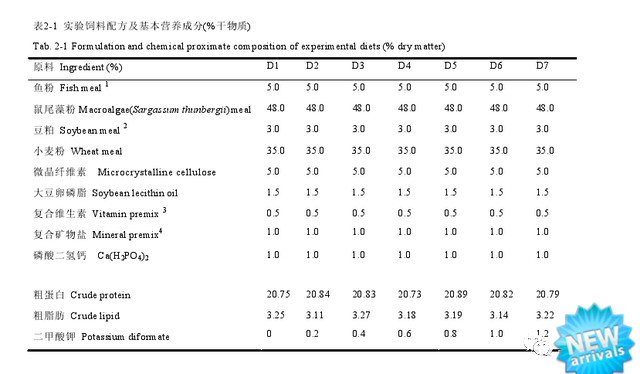With the expansion of culture scale and the increase of culture density, the disease of Apostichopus japonicus has become increasingly significant, which has brought serious losses to the aquaculture industry. The diseases of Apostichopus japonicus are mainly caused by bacteria, viruses and ciliates, among which the skin rot syndrome caused by Vibrio brilliant is the most serious. With the aggravation of the disease, the body wall of Apostichopus japonicus ulcers, forming blue and white spots, and finally self dissolves to death, dissolving into nasal mucus like colloid. In the traditional disease prevention and treatment, antibiotics are widely used. But the long-term use of antibiotics not only has the hidden danger of bacterial resistance and drug residues, but also brings food safety and environmental pollution. Therefore, the development of a non polluting, non residue, safe preparation to reduce the disease of sea cucumber is one of the hot spots of current research.
Potassium diformate is a white crystalline loose powder, dry and tasteless. It is the first non antibiotic feed additive approved by the European Union to replace antibiotics. It can promote the growth of cultured animals, inhibit the growth of harmful bacteria, and improve the intestinal environment, Potassium diformate can significantly improve the growth and yield of aquatic organisms.
1 Test results
1.1 Effects of dietary potassium diformate on growth and survival of sea cucumber Apostichopus japonicus
The specific growth rate of Apostichopus japonicus increased significantly with the increase of dietary potassium diformate content. When the dietary potassium diformate content reached 0.8%, that is, when the dietary potassium diformate content was 1.0% and 1.2%, the specific growth rate of Apostichopus japonicus was significantly higher than that of other treatments, But there was no significant difference (P > 0.05) (table 2-2). The survival rate of sea cucumber was 100% in all groups.
1.2 Effects of dietary potassium diformate on immune indexes of sea cucumber Apostichopus japonicus
Compared with the control group, different levels of potassium dicarboxylate could improve the phagocytic capacity of coelomocytes and the production of O2 – in different degrees (table 2-3). When potassium diformate was added at 1.0% and 1.2%, the phagocytic activity of coelomocytes and the production of reactive oxygen species O2 – in sea cucumber were significantly higher than those in the control group, but there were no significant differences between the 1% and 1.2% potassium diformate groups, or between other levels of potassium diformate and the control group. With the increase of potassium dicarboxylate content in feed, the SOD and NOS of sea cucumber increased.
1.3 Effect of dietary potassium diformate on the resistance of sea cucumber to Vibrio brilliant infection
1.4 Days after challenge, the cumulative mortality of sea cucumber in control group was 46.67%, which was significantly higher than that in 0.4%, 0.6%, 0.8%, 1.0% and 1.2% potassium diformate groups (26.67%, 26.67%, 30%, 30% and 23.33%), but there was no significant difference with 0.2% treatment group (38.33%). The mortality of sea cucumber in 0.4%, 0.6%, 0.8%, 1.0% and 1.2% potassium diformate groups had no significant difference.
2. Discussion
2.1 Effect of potassium dicarboxylate on the growth of sea cucumber Apostichopus japonicus
In animals, the mechanism of action of potassium dicarboxylate is mainly to enter the gastrointestinal tract, improve the gastrointestinal environment, regulate pH, and kill harmful bacteria (Ramli and sunanto, 2005). In addition, potassium diformate can also promote the absorption of nutrients in feed and improve the digestibility and utilization rate of cultured animals. In the application of aquatic animals, experiments have shown that potassium diformate can significantly improve the growth and survival rate of shrimp (he Suxu, Zhou Zhigang, et al., 2006). In this study, the growth of sea cucumber (Apostichopus japonicus) was promoted by adding potassium dicarboxylate to feed, which was consistent with the results of potassium dicarboxylate application in piglets and finishing pigs reported by verland. M (2000).
2.2 Effect of potassium dicarboxylate on immunity of sea cucumber Apostichopus japonicus
Apostichopus japonicus has the same defense mechanism as other echinoderms, which is completed by cellular and non cellular (humoral) immune response. It is mainly used to identify and eliminate foreign bodies entering the animal body, or make foreign bodies into harmless substances, and repair wounds. The cellular immune response of echinoderms is completed by a variety of coelomocytes, which form the defense system of echinoderms. The main functions of these cells include phagocytosis, cytotoxin reaction, and the production of antibacterial substances at the coagulation level (kudriavtsev, 2000). In the process of phagocytosis, coelomocytes can be induced by bacteria or bacterial cell wall components to produce reactive oxygen species (ROS), including no, H2O2, oh and O2 -. In this experiment, adding 1.0% and 1.2% potassium dicarboxylate to the diet significantly increased the phagocytic activity of coelomocytes and the production of reactive oxygen species. However, the mechanism of potassium diformate increasing the phagocytic activity and O2 – production needs to be further studied.
2.3 Effect of potassium dicarboxylate on intestinal flora of sea cucumber Apostichopus japonicus
Potassium dicarboxylate can be decomposed into formic acid and formate in the weak alkaline environment and enter into microbial cells through the cell membrane. It can change the living environment of harmful microorganisms such as Escherichia coli and Salmonella by changing the pH value inside the cells and preventing their reproduction, so as to regulate the intestinal microecological balance (eidelsburger, 1998). The effect of potassium dicarboxylate on intestinal microflora, macroscopically, the H + produced by decomposition of potassium dicarboxylate reduces the pH value in the intestine and inhibits the growth of intestinal microflora. Microscopically, H + enters into bacterial cells through cell membrane, directly destroys the activity of intracellular enzymes, affects the metabolism of microbial protein and nucleic acid, and plays a role in sterilization (Roth, 1998). The results showed that potassium diformate had little effect on the total intestinal bacteria of sea cucumber, but it could significantly inhibit the number of Vibrio.
2.4 Effect of potassium dicarboxylate on disease resistance of sea cucumber Apostichopus japonicus
Vibrio splendens is the pathogenic bacteria of skin rot syndrome of sea cucumber, which is harmful to the production and cultivation of sea cucumber. This experiment proved that adding potassium dicarboxylate in the feed reduced the mortality of sea cucumber infected with Vibrio brilliant. This may be related to the inhibitory effect of potassium diformate on Vibrio.
3 Conclusion
The results showed that dietary potassium diformate had a significant effect on the growth of Apostichopus japonicus, had a positive effect on the non-specific immunity of Apostichopus japonicus, and enhanced the humoral and cellular immunity of Apostichopus japonicus. The addition of potassium dicarboxylate in the diet significantly reduced the number of harmful bacteria in the intestines of sea cucumber, and enhanced the disease resistance of sea cucumber infected with Vibrio brilliant. In conclusion, potassium dicarboxylate can be used as an immune enhancer in sea cucumber feed, and the appropriate dosage of potassium dicarboxylate is 1.0%.
Post time: May-13-2021





